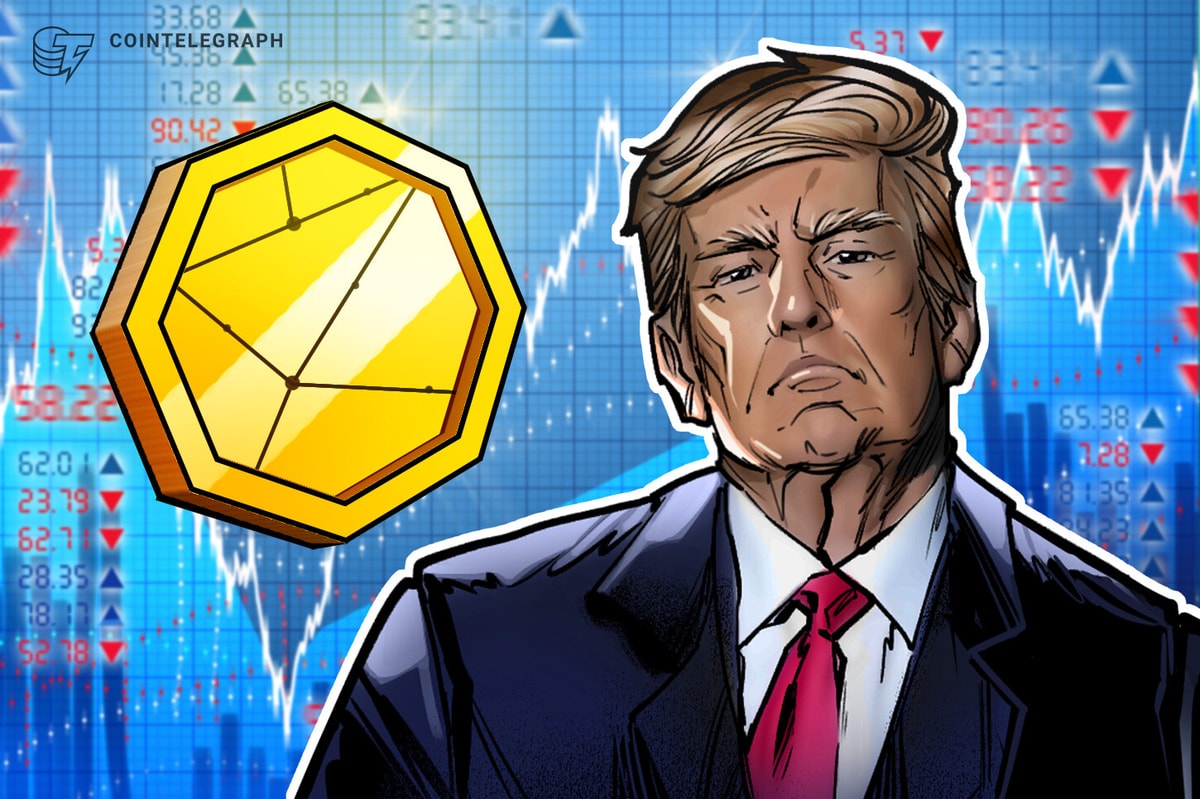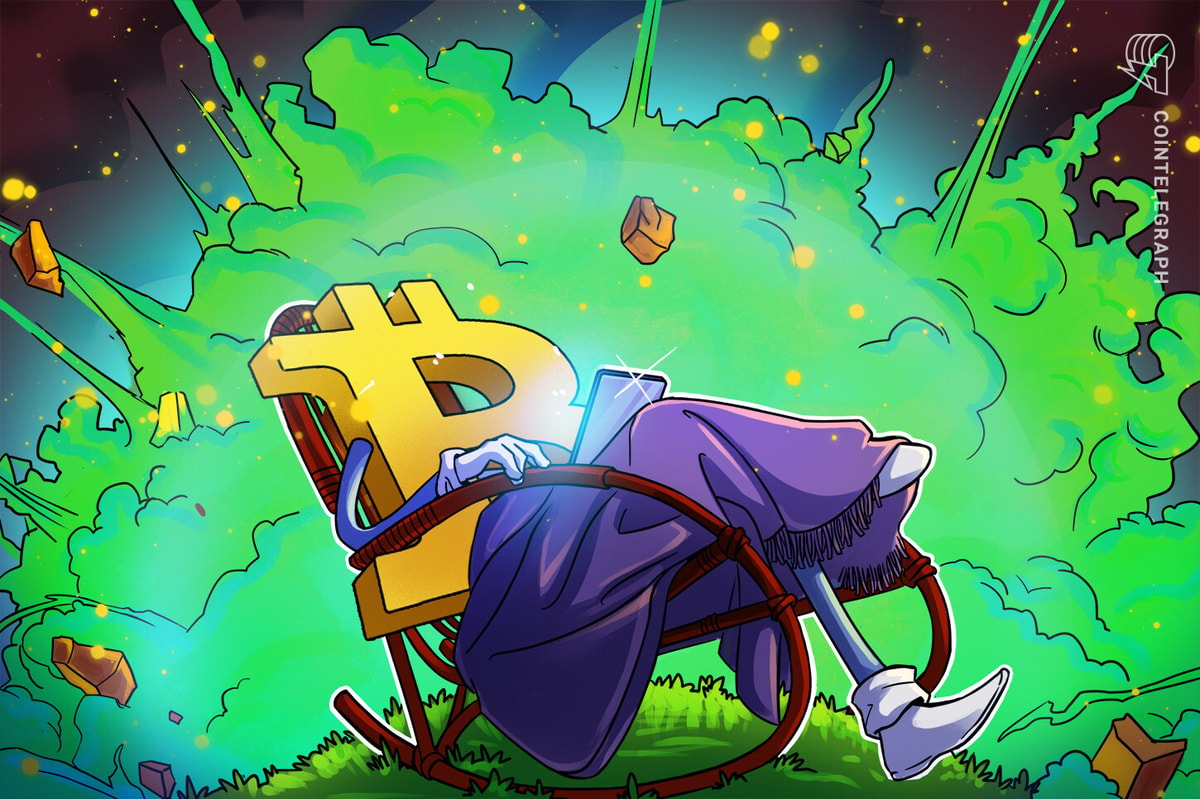Uncategorized
Bitcoin traders are overstating the impact of the US-led tariff war on BTC price
Published
2 weeks agoon
By
admin
Despite Bitcoin’s 2.2% gains on April 1, BTC (BTC) hasn’t traded above $89,000 since March 7. Even though the recent price weakness is often linked to the escalating US-led global trade war, several factors had already been weighing on investor sentiment long before President Donald Trump announced the tariffs.
Some market participants claimed that Strategy’s $5.25 billion worth of Bitcoin purchases since February is the primary reason BTC has held above the $80,000 support. But, regardless of who has been buying, the reality is that Bitcoin was already showing limited upside before President Trump announced the 10% Chinese import tariffs on Jan. 21.
Gold/USD (left) vs. Bitcoin/USD (right). Source: TradingView / Cointelegraph
The S&P 500 index hit an all-time high on Feb. 19, exactly 30 days after the trade war began, while Bitcoin had repeatedly failed to hold above $100,000 for the previous three months. Although the trade war certainly affected investor risk appetite, strong evidence suggests Bitcoin’s price weakness started well before President Trump took office on Jan. 20.
Spot Bitcoin ETFs inflows, strategic Bitcoin reserve expectations and inflationary trends
Another data point that weakens the relation with tariffs is the spot Bitcoin exchange-traded funds (ETFs), which saw $2.75 billion in net inflows during the three weeks following Jan. 21. By Feb. 18, the US had announced plans to impose tariffs on imports from Canada and Mexico, while the European Union and China had already retaliated. In essence, institutional demand for Bitcoin persisted even as the trade war escalated.
Part of Bitcoin traders’ disappointment after Jan. 21 stems from excessive expectations surrounding President Trump’s campaign promise of a “strategic national Bitcoin stockpile,” mentioned at the Bitcoin Conference in July 2024. As investors grew impatient, their frustration peaked when the actual executive order was issued on March 6.
A key factor behind Bitcoin’s struggle to break above $89,000 is an inflationary trend, reflecting a relatively successful strategy by global central banks. In February, the US Personal Consumption Expenditures (PCE) Price Index rose 2.5% year-over-year, while the eurozone Consumer Price Index (CPI) increased by 2.2% in March.
Investors turn more risk-averse following weak job market data
In the second half of 2022, Bitcoin’s gains were driven by inflation soaring above 5%, suggesting that businesses and families turned to cryptocurrency as a hedge against monetary debasement. However, if inflation remains relatively under control in 2025, lower interest rates would favor real estate and stock markets more directly than Bitcoin, as reduced financing costs boost those sectors.
US CPI inflation (left) vs. US 2-year Treasury yield (right). Source: TradingView
Related: Coinbase sees worst quarter since FTX collapse amid industry bloodbath
The weakening job market also dampens traders’ demand for risk-on assets, including Bitcoin. In February, the US Labor Department reported job openings near a four-year low. Similarly, yields on the US 2-year Treasury fell to a six-month low, with investors accepting a modest 3.88% return for the safety of government-backed instruments. This data suggests a rising choice for risk aversion, which is unfavorable for Bitcoin.
Ultimately, Bitcoin’s price weakness stems from investors’ unrealistic expectations of BTC acquisitions by the US Treasury, declining inflation supporting potential interest rate cuts, and a more risk-averse macroeconomic environment as investors turn to short-term government bonds. While the trade war has had negative effects, Bitcoin was already showing signs of weakness before it began.
This article is for general information purposes and is not intended to be and should not be taken as legal or investment advice. The views, thoughts, and opinions expressed here are the author’s alone and do not necessarily reflect or represent the views and opinions of Cointelegraph.
Crypto markets ‘relatively orderly’ despite Trump tariff chaos: NYDIG Fartcoin ‘Hot Air Rises’ — $1.50 Just A Whiff Away What happened to the RWA token? Crypto Strategist Sees Solana-Based Memecoin Surging Higher, Says One AI Altcoin Flashing Strong Chart Mantra Team Responds As The OM Token Price Crashes Over 80% In 24 Hours This Week in Crypto Games: Gaming Tokens Crash Out, Eve Frontier Opens Up Published on By Crypto markets have been fairly stable amid wider market panic caused by US President Donald Trump’s “on-again, off-again” sweeping global tariffs, according to a New York Digital Investment Group (NYDIG) analyst. “Despite the carnage in traditional financial markets, the crypto markets have been relatively orderly,” NYDIG global head of research Greg Cipolaro said in an April 11 note. “Historically, in broad risk-off moves, we tend to see stresses show up in crypto markets. We have yet to see that.” Cipolaro said crypto perpetual futures rates have “been persistently positive,” with liquidations spiking on April 6 and 7 in the days after Trump first announced the tariffs on April 2 but only to a total of $480 million, which he added “was well below other notable liquidation events.” He noted that the price of Tether (USDT), a US dollar-tracking stablecoin widely used token in crypto trading, was below $1 but had “not experienced a sharp decline.” Trump unveiled a sweeping tariff regime on April 2 that lumped various levies on every country before pausing them for 90 days just hours after they came into effect on April 9 and instead charging a base tariff of 10%, besides China, which currently has tariffs of up to 145%. Traditional and crypto markets tanked after Trump’s April 2 tariff announcement, and many assets haven’t recovered to the same level as before their unveiling. Stocks, bonds and foreign exchange volatility rates all rose after Trump’s tariffs announcement. Source: NYDIG Over the weekend, the Trump administration caused more confusion with its tariffs, saying on April 13 that an April 11 decision to exempt many electronics from tariffs was temporary and they would still be hit with levies. Cipolaro said that Bitcoin (BTC) didn’t escape the market volatility, “but at current prices has fared far better than many other asset classes.” He added that Bitcoin’s volatility hasn’t risen to historic levels, unlike the traditional markets, and “has been relatively stable” despite instability instigated by the Trump administration. “Perhaps investors are increasingly searching for stores of value not tied to sovereign countries and thus not affected by the trade turmoil.” Bitcoin is down 22.5% from its mid-January peak of over $108,000 and has traded flat over the past 24 hours at $84,730, according to CoinGecko. Cipolaro said the narrowing gap between Bitcoin’s volatility and other assets makes it “increasingly more appealing” to funds with risk parity portfolios — those that use risk to choose asset allocations. He added that investors are likely reducing their risk exposure but “perhaps some reallocation of asset mix to Bitcoin is one of the reasons it has been more buoyant.” Related: S&P 500 briefly sees ‘Bitcoin-level’ volatility amid Trump tariff war “Risk parity funds allocating to Bitcoin can help dampen its volatility — making the asset more attractive and potentially reinforcing a virtuous cycle of increased adoption and stability,” Cipolaro said. However, YouHodler chief of markets Ruslan Lienkha told Cointelegraph in an April 12 note that despite a wider market rebound, “technical indicators are painting a concerning picture.” He said a “death cross,” when the 50-day moving average crosses below the 200-day moving average, is potentially forming on Bitcoin and the S&P 500. Lienkha said the pattern is “generally considered a bearish signal for the medium term, suggesting that markets may struggle to sustain upward momentum without a clear catalyst or a stream of positive macroeconomic developments.” Magazine: Financial nihilism in crypto is over — It’s time to dream big again Published on By Commerce Secretary Howard Lutnick walked back the recent reciprocal tariff exemption on select electronics announced in an April 12 bulletin from the United States Customs and Border Protection. On April 13, Lutnick told ABC News that the reciprocal tariff exemption was temporary until the administration established a sector tariff regime for semiconductor products, which includes phones, graphics processors, and computing chips in a “month or two.” Lutnick added: “President Trump has called out pharmaceuticals, semiconductors, and autos. He called them sector tariffs, and those are not available for negotiation. They are just going to be part of making sure we ensure core national security items are made in this country.” “We can’t be relying on China for fundamental things we need. Our medicines and our semiconductors need to be built in America,” Lutnick continued. The official also said he was confident that the US and China would arrive at a trade deal through negotiations. The emphasis on national security and onshoring critical industries could signal that the trade tariffs will be a long-term geostrategic policy and not simply a short-term negotiation tactic to make US exports more attractive, as some analysts have suggested. The Volatility S&P Index (VIX), a measure of the S&P stock index’s volatility, remains elevated amid macroeconomic uncertainty. Source: TradingView Related: Bitcoin ‘decouples,’ stocks lose $3.5T amid Trump tariff war and Fed warning of ‘higher inflation’ Trump’s trade tariffs crashed the stock and crypto markets, wiping away trillions in shareholder value as investors dumped riskier assets on fears of a lengthy trade war between the United States and its trading partners. In an April 10 X Post, Bloomberg analyst Eric Balchunas cited the SPY US Equity History Volume chart as evidence that the S&P 500 stock market index is now more volatile than Bitcoin (BTC). According to the analyst, the S&P 500 Index hit a volatility level of 74 in April, compared to Bitcoin’s 71. Stocks and crypto pumped following rumors of the Trump administration initiating a 90-day reciprocal tariff pause. Approximately $2 trillion was pumped into stocks on rumors of softer trade policies. Much of this value was then wiped away when Trump claimed that rumors of a 90-day pause were false and returned once the Trump administration did, in fact, issue a reciprocal tariff pause in the following days. Magazine: Financial nihilism in crypto is over — It’s time to dream big again Published on By Bitcoin (BTC) hit an eleven-day high on April 13 as the crypto market relief rally closely tracked US financial policy changes. BTC/USD 1-hour chart. Source: Cointelegraph/TradingView Data from Cointelegraph Markets Pro and TradingView showed BTC/USD reaching $86,000 for the first time since April 2. The pair had reacted well to news that US President Donald Trump had decided to exclude certain key products from his ongoing trade tariffs against China. Traditional markets are closed on weekends —creating lower-liquidity trading in crypto markets and raising the chance for price volatility— with Bitcoin subsequently dropping under $84,000. With hours to go until the weekly close, BTC/USD was thus up 7% for the week, having started with a trip to new five-month lows. Commenting, traders were cautious over BTC price strength. Call me crazy but I don’t think I trust this breakout on $BTC. Low volume, overbought stoch, and on a weekend. If we can remain over 84k through Monday I’ll look for higher but for now this seems sketchy. pic.twitter.com/qKVdYAOYPJ — Roman (@Roman_Trading) April 12, 2025 Daan Crypto Trades noted the ongoing interplay with the 200-day exponential moving average (EMA) at $85,000. “This is however still a weekend move so far and we know next week will be volatile again with news regarding tariffs and the first big tech earnings coming up,” part of a post on X read. BTC/USD 1-day chart with 200 EMA. Source: Cointelegraph/TradingView Well-known trader Peter described the rebound from the lows as looking “more corrective than it does impulsive.” BTC/USD 2-hour chart. Source: Peter Brandt/X Popular trader and analyst Rekt Capital meanwhile saw the true hurdle to a Bitcoin bull market rebound coming in the form of a stubborn long-term daily downtrend. “Bitcoin has Daily Closed above the Downtrend. Thus, breakout confirmation is underway,” one of his latest X updates explained alongside an illustrative chart. “However BTC has previously Daily Closed above the Downtrend but failed its retest (a few of the red circles). Retest needs to be successful and it is in progress.” BTC/USD 1-day chart. Source: Rekt Capital/X As Cointelegraph reported, the daily downtrend, in place since late 2024, is earmarked as a key hurdle for bulls to overcome. Related: Bollinger Bands creator says Bitcoin forming ‘classic’ floor near $80K Another post flagged promising signals on Bitcoin’s relative strength index (RSI) indicator. A classic leading indicator, RSI continued to print another bullish divergence with price on daily timeframes. “Bitcoin is developing yet another Higher Low on the RSI while forming Lower Lows on the price,” Rekt Capital summarized. “Overall, throughout the cycle Bitcoin has formed Bullish Divergences like this on a few occasions already. Each Bull Div preceded reversals to the upside.” BTC/USD 1-day chart with RSI data. Source: Rekt Capital/X This article does not contain investment advice or recommendations. Every investment and trading move involves risk, and readers should conduct their own research when making a decision. Arthur Hayes, Murad’s Prediction For Meme Coins, AI & DeFi Coins For 2025 Expert Sees Bitcoin Dipping To $50K While Bullish Signs Persist Aptos Leverages Chainlink To Enhance Scalability and Data Access Bitcoin Could Rally to $80,000 on the Eve of US Elections Crypto’s Big Trump Gamble Is Risky Sonic Now ‘Golden Standard’ of Layer-2s After Scaling Transactions to 16,000+ per Second, Says Andre Cronje Institutional Investors Go All In on Crypto as 57% Plan to Boost Allocations as Bull Run Heats Up, Sygnum Survey Reveals Ripple-SEC Case Ends, But These 3 Rivals Could Jump 500x
Source link You may like












Uncategorized
Crypto markets ‘relatively orderly’ despite Trump tariff chaos: NYDIG

Bitcoin fares well, declining volatility to make it widely attractive
Source link Uncategorized
Commerce Secretary Lutnick walks back tariff relief on electronics

Trade war heightens volatility and sends markets tumbling
Source link Uncategorized
Bitcoin price tags $86K as Trump tariff relief boosts breakout odds

Bitcoin traders say brace for more volatility
RSI bullish divergence still in play
Source link Michael Saylor Teases New Bitcoin Buy After Strategy’s $7.69 Billion Q1 BTC Buying Spree

Crypto markets ‘relatively orderly’ despite Trump tariff chaos: NYDIG

Fartcoin ‘Hot Air Rises’ — $1.50 Just A Whiff Away

What happened to the RWA token?

Crypto Strategist Sees Solana-Based Memecoin Surging Higher, Says One AI Altcoin Flashing Strong Chart

Mantra Team Responds As The OM Token Price Crashes Over 80% In 24 Hours

This Week in Crypto Games: Gaming Tokens Crash Out, Eve Frontier Opens Up

Commerce Secretary Lutnick walks back tariff relief on electronics

Gold ETF Inflows Hit Three-Year High as PAXG, XAUT Outperform Wider Crypto Market

Israel’s New Study Shows 51% Of Public Is Interested In Adopting CBDC (Digital Shekel) – Is That So?

Solana Price Eyes Breakout Toward $143 As Inverse Head & Shoulders Pattern Takes Shape On 4-hour Chart

Crypto malware silently steals ETH, XRP, SOL from wallets

Binance Executives Met With US Government Officials To Discuss Easing of Regulatory Supervision: Report

Michael Saylor Hints At Another MicroStrategy Bitcoin Purchase, BTC Price To Rally?

From the Crypto Trenches to the Hill: Why Solana Is Making a Big Push in Washington

Arthur Hayes, Murad’s Prediction For Meme Coins, AI & DeFi Coins For 2025

Expert Sees Bitcoin Dipping To $50K While Bullish Signs Persist

Aptos Leverages Chainlink To Enhance Scalability and Data Access

Bitcoin Could Rally to $80,000 on the Eve of US Elections

Crypto’s Big Trump Gamble Is Risky

Sonic Now ‘Golden Standard’ of Layer-2s After Scaling Transactions to 16,000+ per Second, Says Andre Cronje

Institutional Investors Go All In on Crypto as 57% Plan to Boost Allocations as Bull Run Heats Up, Sygnum Survey Reveals

Ripple-SEC Case Ends, But These 3 Rivals Could Jump 500x

Has The Bitcoin Price Already Peaked?

A16z-backed Espresso announces mainnet launch of core product

The Future of Bitcoin: Scaling, Institutional Adoption, and Strategic Reserves with Rich Rines

3 Voting Polls Show Why Ripple’s XRP Price Could Hit $10 Soon

Xmas Altcoin Rally Insights by BNM Agent I

Blockchain groups challenge new broker reporting rule

I’m Grateful for Trump’s Embrace of Bitcoin
Trending


















